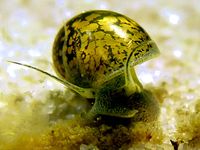Difference between revisions of "Physa acuta"
From The Aquarium Wiki
(the synonyms) (Tag: Visual edit) |
(Tag: Visual edit) |
||
| Line 37: | Line 37: | ||
===Synonyms=== | ===Synonyms=== | ||
| − | :{{sn|Physella acuta}} | + | :{{sn|Physella acuta}} |
== Sexing == | == Sexing == | ||
| Line 54: | Line 54: | ||
:Prefers fairly still but well oxygenated water. Can survive in outdoor ponds and found throughout waterways in Europe. When found in a tropical aquarium, the snail will be much more active and prolific. | :Prefers fairly still but well oxygenated water. Can survive in outdoor ponds and found throughout waterways in Europe. When found in a tropical aquarium, the snail will be much more active and prolific. | ||
| − | == | + | == Behavior == |
:A fast moving snail. This snail can often come into fish tanks as a pest snail hidden away in plants and will multiply in number. | :A fast moving snail. This snail can often come into fish tanks as a pest snail hidden away in plants and will multiply in number. | ||
Revision as of 17:07, 8 November 2018
Bladder Snail
Physa acuta
19 Litres (5 US G.)
0.6-1.3cm (0.25-0.5 ")
Freshwater
7.2 - 8.5
18 -25 °C (64.4-77°F)
6-12 °d
1:1 M:F
3-5 years
This animal is available captive bred
Contents
Alternative names
- Bladder Snail, Acute Bladder Snail, European physa, Tadpole Snail
Synonyms
- Physella acuta
Sexing
- These snails are hermaphroditic.
Tank compatibility
- A peaceful snail, will not bother tank inhabitants. However, should not be kept with aggressive fish that may attack it such as Loaches or Pufferfish.
Diet
- Omnivorous, will graze around the environment, will eat plants, dead and decaying matter, and algae wafers.
Feeding regime
- Will constantly graze.
Environment Specifics
- Prefers fairly still but well oxygenated water. Can survive in outdoor ponds and found throughout waterways in Europe. When found in a tropical aquarium, the snail will be much more active and prolific.
Behavior
- A fast moving snail. This snail can often come into fish tanks as a pest snail hidden away in plants and will multiply in number.
Identification
- The juveniles are small, initially about 1 mm in diameter. Their shells may be clear and transparent for the first to two months of life depending on water conditions.
- The adults have a smooth brown speckled oval shell with 3-4 whorls, the last whorl of the shell is very much expanded, so it's larger than all of the remaining spire. Has slender antennae and does not possess an operculum.

